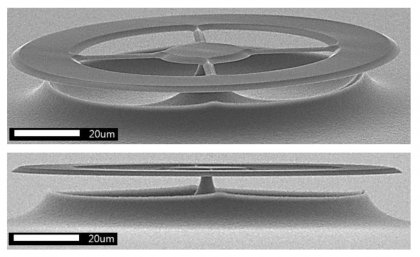
A new and extremely sensitive method of measuring ultrasound could revolutionise everything from medical devices to unmanned vehicles.
Researchers at The University of Queensland have combined modern nanofabrication* and nanophotonics* techniques to build the ultraprecise ultrasound sensors on a silicon chip.
Professor Warwick Bowen, from UQ’s Precision Sensing Initiative and the Australian Centre for Engineered Quantum Systems, said the development could usher in a host of exciting new technologies.
“This is a major step forward, since accurate ultrasound measurement is critical for a range of applications,” he said.
“Ultrasound is used for medical ultrasound, often to examine pregnant women, as well as for high resolution biomedical imaging to detect tumours and other anomalies.
“It’s also commonly used for spatial applications, like in the sonar imaging of underwater objects or in the navigation of unmanned aerial vehicles.
“Improving these applications requires smaller, higher precision sensors and, with this new technique, that’s exactly what we’ve been able to develop.”
The technology is so sensitive that it can hear, for the first time, the miniscule random forces from surrounding air molecules.
“We’ve developed a near perfect ultrasound detector, hitting the limits of what the technology is capable of achieving,” Professor Bowen said.
“We’re now able to measure ultrasound waves that apply tiny forces – comparable to the gravitational force on a virus – and we can do this with sensors smaller than a millimetre across.”
Research leader Dr Sahar Basiri-Esfahani, now at Swansea University, said the accuracy of the technology could change how scientists understand biology.
“We’ll soon have the ability to listen to the sound emitted by living bacteria and cells,” she said.
“This could fundamentally improve our understanding of how these small biological systems function.
“A deeper understanding of these biological systems may lead to new treatments, so we’re looking forward to seeing what future applications emerge.”
The research, supported by the Australian Research Council, the European Union’s Horizon 2020 research and innovation programme, the Welsh Government, and the United States Air Force Office of Scientific Research, is published in Nature Communications (DOI: 10.1038/s41467-018-08038-4).
Media: Professor Warwick Bowen, wbowen@physics.uq.edu.au, +61 404 618 722; Dominic Jarvis, dominic.jarvis@uq.edu.au, +61 413 334 924.
*Nanofabrication is the design and manufacture of devices with dimensions measured in nanometres. One nanometer is 10 -9 metre, or a millionth of a millimetre. Nanophotonics or nano-optics is the study of the behaviour of light on the nanometre scale, and of the interaction of nanometre-scale objects with light. It is a branch of optics, optical engineering, electrical engineering, and nanotechnology.
.jpg)











